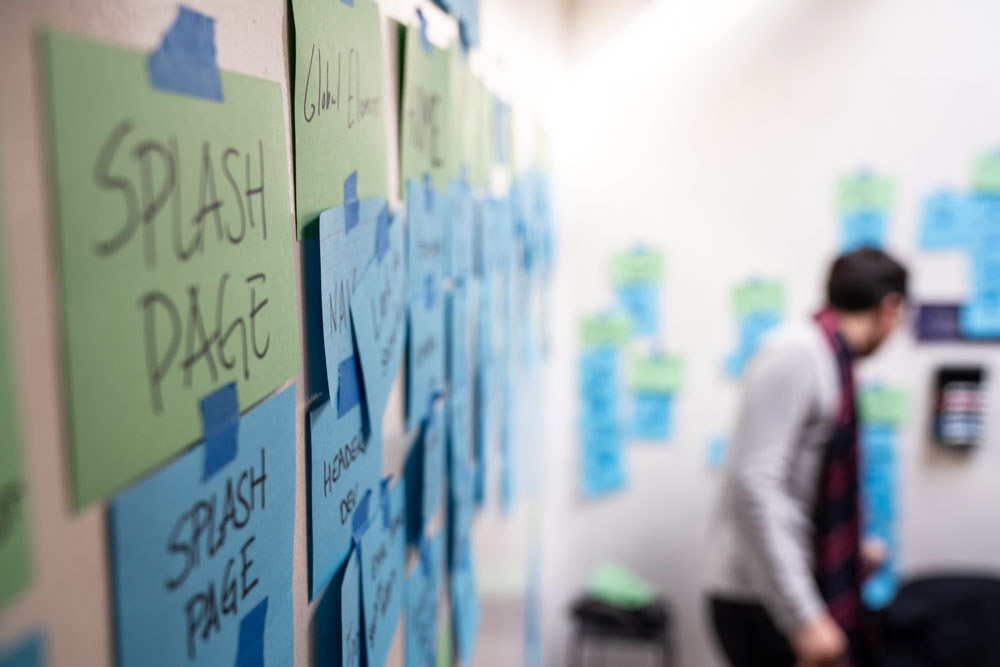AgencyDocs is a collection of documents and templates based on our work at Barrel. It’s an e-commerce store where other agency owners or managers can buy things like our employee onboarding checklist, our project brief template, or our functional spec document.
Back in 2013, I wrote how I would gladly have paid for access to another agency’s documents to see how they did things. Over the years, we’ve seen bits and pieces of various documents through our association with various agency groups and with employees who worked at other companies before coming to ours. But I still felt that a website with a well-organized cache of docs could be a good resource, especially for new, up-and-coming firms who perhaps did not have many processes figured out.
I’ve launched various internal projects at Barrel over the years that were exciting, fun, and ultimately very painful. These projects included: a WordPress theme for viral marketing (over 40,000 downloads); a project-tracking software-as-a-service (SaaS) tool (over 10,000 users); three Shopify themes (installed on over 2,000 e-commerce stores); and a performance management tool for 360-style reviews on projects (never publicly released). While I am proud that these projects served various customers well and were of good quality, I regret the haphazard planning (100% my fault) that put our internal resources in a crunch and also left many of these products half-baked in the long-run due to neglect. It was only earlier this year that we shut down the last of these projects after a prolonged and annoying wind-down process.
With AgencyDocs, I vowed to learn from my lesson. I wanted to launch something that followed these rules:
- The project must directly benefit our core business, which is serving our clients.
- The project should not require any design or web development resources and should be something that our leadership team can handle without assistance.
To the first point, AgencyDocs has made it necessary for us to examine our own processes and to take account of what’s working well and what isn’t. In order for us to generate documents that may ultimately be useful to many other agencies, we’ve had to streamline some to be more flexible and generic. This process has presented an opportunity for us to improve existing documents and to question decisions we made some time ago. In my book, this is a direct benefit to our core business.
Another reason why AgencyDocs benefits our core business is that it can serve as a sandbox for us to test out various e-commerce tools and digital marketing tactics. I think having our own live e-commerce website with real customers will give us a golden opportunity to experiment with some interesting ideas and fine-tune them before rolling them out to our clients.
To the second point, this is where I promised myself not to start on a project that might eventually become a time suck for the rest of the team. My initial impulse was to get a few hours from a designer to get some branding done and a developer to help with the site theme, but then I told myself that I should try to do it all on my own.
The Store is the Easy Part
We build most of our clients’ e-commerce website on Shopify. It’s a fast-growing platform that’s become more ubiquitous in recent years. I personally like how easy it is to use and appreciate the attention they’ve put into the admin experience.
To get AgencyDocs started, I fired up a dev store using our Barrel Shopify Partner portal. This is not so different from signing up for a 14-day free trial off the Shopify site. I then went in and browsed for an appropriate theme to use. I actually liked the default Debut theme that was already installed, so I left things the way they were.
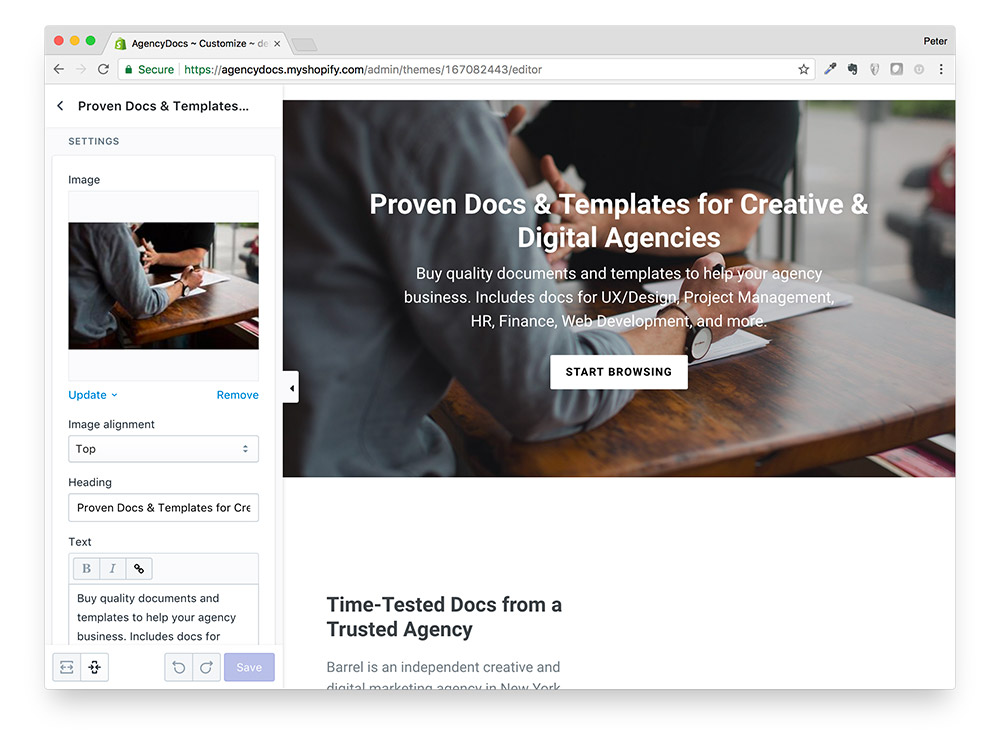
Customizing the theme in Shopify was as easy as filling out a few fields.
Next, I went through the online store settings and quickly filled out and updated everything. These are some of the key things I did in about an hour’s worth of time:
- Customized homepage settings (Online Store >> Themes >> Customize) by changing logo, font, text/link colors, the sections on the page, the images, and the text
- I created the logo in Adobe Illustrator. Took me about 5 minutes. I used Avenir Next Condensed and picked a shade of blue.
- I found a stock image for the hero from Unsplash, a site where you can get free images to use on your projects.
- I also pulled an image from our Barrel team photo collection.
- I kept the copy brief and wrote what I thought would appeal to an agency owner.
- Customized the website navigation (Online Store >> Navigation) by simplifying the footer nav and adding a few links to the main top menu
- Filled out everything under Preferences (Online Store >> Preferences)
- Title and meta description: I played around with variations of the tagline and came up with a short description that would show up on search engine results.
- Google Analytics: I created a profile under our Barrel Analytics account and pasted the tracking ID here
- Facebook Pixel: I created an Ad Account under Facebook Business Manager, generated a pixel, and pasted the ID here
- Set up payment provider (Settings >> Payments)
- Selected Shopify Payments, which runs on Stripe, as our payment provider (2.9% + 30¢ per transaction for the $29/month Shopify plan that we’re on; it’s less for higher plans)
- Customize checkout page (Settings >> Checkout) to add the logo and adjust some colors and to make sure refund, privacy policy, and terms of service text are in place.
I then installed a couple of apps to the store: Digital Downloads, which lets you attach files to products that become available after customers pay and MailChimp for Shopify, which helps connect Shopify with MailChimp, a popular email marketing tool.
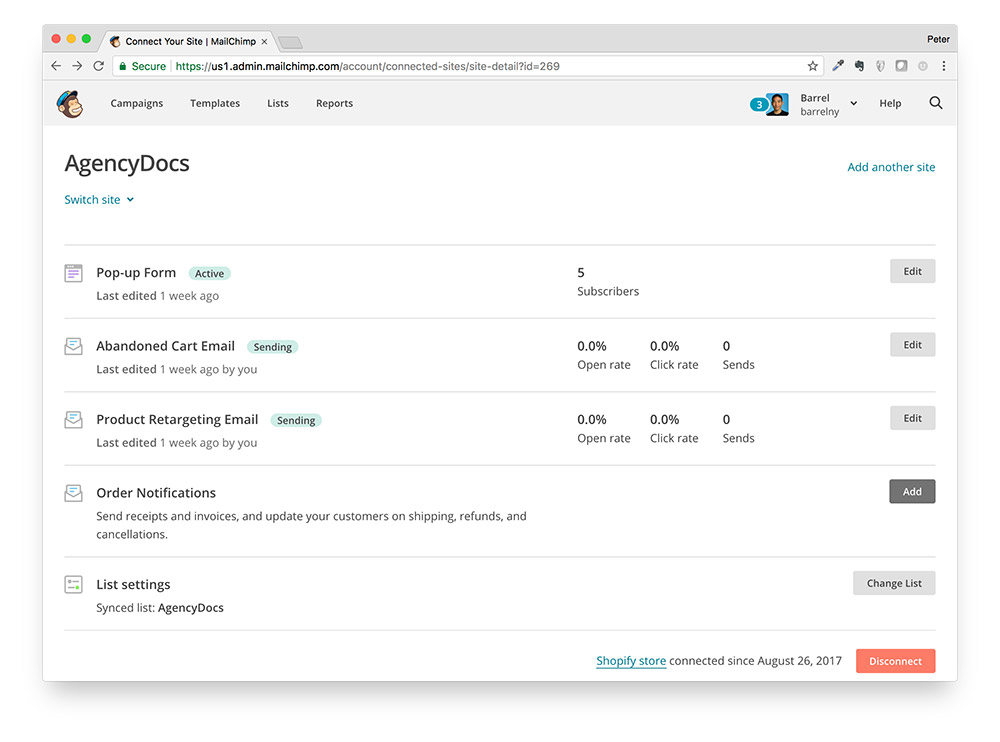
Once you connect your Shopify account with MailChimp, you’ll be able to customize a pop-up and various automated emails from the Connected Sites section.
Once MailChimp was in place, I spent an hour customizing various elements. These included:
- A welcome email that gave customers a free “gift” document, a checklist to use before kicking off a project and before launching a website.
- A pop-up form encouraging people to sign up for our email list.
- An abandoned cart email that goes out when people add a product to cart but don’t check out.
- A product retargeting email that suggests different products to people who visited the site and viewed products.
I didn’t change the design much other than uploading the logo. I spent most of my time tweaking some copy. By setting these automations up, I know that MailChimp will ping customers and guide them to take different actions without me doing anything.
With these fairly straightforward steps, the skeleton of the website was in place. All I would need to do is write some content for the FAQ, upload the product, and get a domain name registered. Of course, one of those things, the product, would be the most important part of this entire project.
The Product
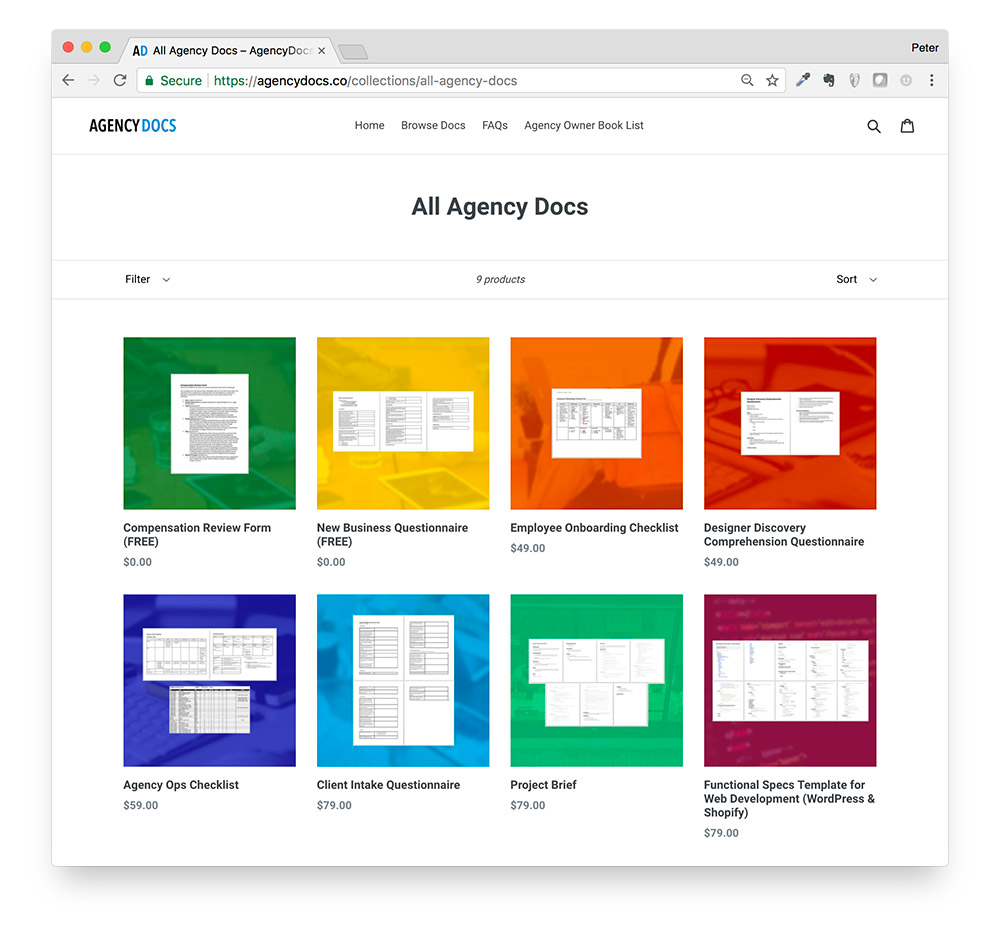
The documents, our core product for AgencyDocs, is the most time-consuming and most valuable part of the e-commerce website.
Before I started on the website, my goal was to get together about 10 or so docs before officially launching. Before that, I set a goal to get 4 docs in place before doing a soft launch where I would get the website live, show it to some friends, and get some feedback. The 4 docs I decided to put up were:
- Ops Checklist: what we use to track various HR, finance, and office activities that need to happen each day, week, and month (also comes with a Supplies Inventory Checklist)
- Client Intake Questionnaire: what we use at the start of new client engagements to learn about our clients, their industry, their customers, and their goals
- Project Brief: the document we use to inform our internal team of a client, the project’s objectives, and various details about what we need to get done prior to kickoff
- Employee Onboarding Checklist: what we use to ensure that new team members are properly set up and equipped to begin their role at Barrel
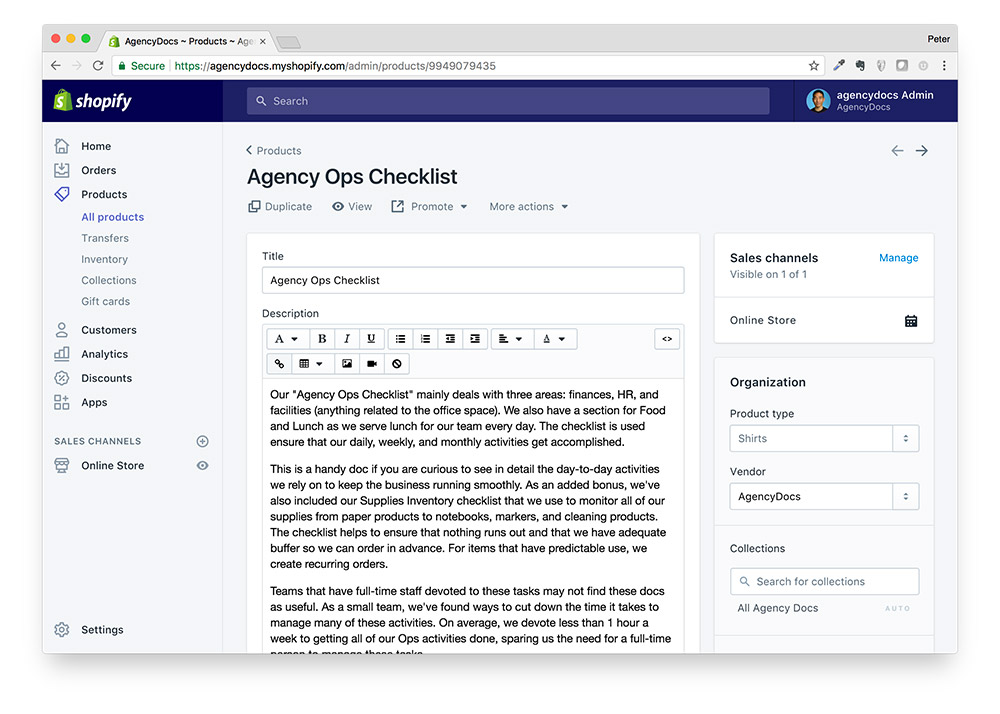
I spent a good amount of time writing the product descriptions to help potential customers know how and when these docs were used at Barrel.
Each product required a thorough review of the doc to ensure that they were general enough to be of value to another agency. I edited places where I thought the description or text was too specific to something we did internally and also added some guiding text to provide context. I stripped each doc of our Barrel branding so that they would be generic files that could easily be copied and pasted into another agency’s branded template.
After making sure the doc was in a good place, I spent a good chunk of time writing the product description and creating a thumbnail showing a zoomed out view of the doc to show how many pages and text density the customer could expect. For each description, I tried to be very specific about how and when we used these docs and how they helped our team. I know that not every doc will be useful to every agency, but my hope is that certain descriptions will hit a chord with an agency owner going through a specific pain point that can be mitigated by referencing our doc.
I created the product entries in Shopify, loaded in the text and image, and uploaded the file using the Digital Downloads app. All in, the product part of the e-commerce website probably took up 80% of my time. So if you really break it down, the website component that displays content and takes people through a checkout process probably took no more than 90 minutes and the rest of the 8 hours was spent on product. This, of course, is further distorted by the fact that I’ve not created any products from scratch but merely repurposed existing assets. Our checklists, project brief, and questionnaires took shape through the investment of many hours over the course of many years. Some have been tested on dozens of projects, clients, and employees. We’ve tweaked, refined, and rebuilt these docs countless times. Luckily for me, that work was already done in advance so that I may just make mostly cosmetic adjustments. For many others pursuing an e-commerce business, getting the product right will take 99.5% of the time and just 0.5% to deploy on a website. That is probably a more prudent ratio.
Just Halfway There
Now that the website is live and I’ve gotten very close to getting 10 docs up, the halfway point is near. Now the work of marketing and reaching the right people will become my primary focus, and there’s a great deal to be done. I’ve been compiling a list of influencers and giving away copies of docs to various agency owners for free in the hopes of generating some buzz. I’ll be leveraging my membership in different agency groups to offer special deals to members. I’m also compiling a list of various freelancer and website design and development blogs that I can hit up for a mention or blog post about our offering. This is nuts and bolts marketing work, the stuff that requires patience and discipline. I’ll also have to queue up some retargeting ads to serve on Facebook.
I don’t know what to expect from this project. It may end up selling well or it may not sell much at all. Either way, I’m not too worried because it’s something that I’ve kept very contained in terms of time and money investment. Beyond the Shopify $29/month fee and $11.99 for annual domain renewal, there are no other significant costs. I’ve asked my partners to pitch in a few hours here and there to clean up some existing docs that we can use as products. Other than this, it’s mostly an hour or so a day that I’ll be spending to see if this sticks. I’m in no rush and I’m happy to keep this up for a year or longer. If I come across young, up-and-coming creative entrepreneurs starting their own agencies, I’ll tell them to check the site out and maybe give them a discount code or just shoot all the docs to them for free. What I’m most excited for is to keep on growing the library of documents as we continue to streamline processes internally and have good things to share with others. And as a secondary benefit, I hope to try some innovative and interesting experiments with marketing to see how potential customers react and if anything sticks.
It always satisfying to engage in deep activity that brings an idea to life. With AgencyDocs, an idea that’s been percolating for some years now, I’m looking forward to nurturing its growth.
